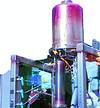
To comply with the Kyoto Protocol, governments around the world are working to substantially reduce CO2 emissions. One way to accomplish this is to improve efficiency by combining electricity power stations and household heat generation. Currently, large power stations generate electricity that is transmitted to households via long cables.
The electricity generation process produces heat as a by-product, but this heat is wasted, because transporting it to homeowners would require a complex pipe infrastructure and would be economically prohibitive.
HydrogenSource, a joint partnership of UTC Fuel Cells and Shell Oil, addressed the problem of heat loss by developing the hydrogen generator for a combined power and heat generation system that resides in the home. Combining the generator with a PEM (proton exchange membrane, also called polymer electrolyte membrane) fuel cell, enables both electricity and heat to be generated at the point of use. Chess Embedded Technology of the Netherlands, was commissioned to develop an embedded controller to maintain the correct settings within the generator. Chess used MathWorks tools to model, simulate, and generate application software for the controller.

The challenge
The revolutionary generator converts natural gas into hydrogen using catalytic converters in a process called catalytic partial oxidation. The hydrogen is then converted to electricity in a fuel cell. The temperatures must be precisely controlled to ensure the correct functioning of the catalytic converter.
HydrogenSource needed a device that could measure and control temperatures, control the pump speeds and the igniters, and maintain an independent safety system. In addition, the control system needed to be economical and easy to maintain. The Chess team was commissioned to build and test all the electronic hardware, design the software that drives the hardware, and develop a tool that would enable HydrogenSource personnel to create new application software for their dedicated hardware modules without having to code in C.
Since they were working under a strict timetable and budget, Chess needed tools that would optimise productivity. It was also essential that the tools be easy to use, as the petrochemists and physicists planned to do their own programming.
Solution
Chess used MATLAB to develop a graphical tool for HydrogenSource. The application consisted of TLC files, make files, libraries, and simulation files. They used Simulink to describe the control algorithms, Stateflow to define the system's startup and shutdown behaviour, and Real-Time Workshop Embedded Coder for automatic code generation. With these tools and hardware, the HydrogenSource team could graphically create and make changes to the application software.
"When the graphical description was ready, compact C code was generated at the touch of a button," says Raj Bose, consultant to Chess. "The code was then transferred from a PC to the controller over an RS232 connection for immediate use."
From energy use analyis, it is expected that the generator will reduce total energy consumption by 25% and hence, will reduce CO2 emissions.
Among the results achieved were a flexible development environment and reduced development time. Explains Bose: "With MathWorks tools, software application changes are made on a graphical level. This means changes can be made within 15 minutes: five minutes for updating the graphical description, five for generating C code, and five for compiling and downloading. This includes documentation!"
"We were able to eliminate the gap between application knowledge and software development knowledge using graphical programming tools from The MathWorks," Bose says. "The petrochemists can now focus on their core competencies instead of spending time on programming."
A further benefit is that collaboration between software engineers, petrochemists, and service engineers is made easier. "With the application that we developed in MATLAB, petrochemists can easily communicate their ideas to software engineers and generate production code without the need for C code development engineers," he concludes.
| Tel: | +27 11 325 6238 |
| Email: | [email protected] |
| www: | www.optinum.co.za |
| Articles: | More information and articles about Opti-Num Solutions |

© Technews Publishing (Pty) Ltd | All Rights Reserved